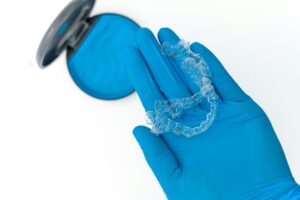Many people turn to Invisalign for a straighter smile, but what if there are gaps due to missing teeth? Invisalign for missing teeth can be an option, but it depends on the specific situation. Some cases allow aligners to close small gaps, while others require additional dental treatments.
Understanding how Invisalign interacts with missing teeth is important before starting treatment. A dentist will assess the size of the gap, the alignment of surrounding teeth, and the best approach for long-term results. For some, Invisalign alone can help. Others may need implants or bridges along with aligners to achieve a complete smile.
How Invisalign Works and Its Role in Dental Gaps
What Invisalign Does
- Invisalign uses a series of clear aligners to shift teeth into place gradually.
- The treatment is designed for mild to moderate misalignments.
- Each set of aligners is worn for about two weeks before switching to the next.
Can Invisalign Close Gaps from Missing Teeth?
- Small gaps can sometimes be closed with aligners.
- Larger gaps may require additional dental solutions.
- If teeth are shifting due to a missing tooth, Invisalign can help prevent further movement.
In some cases, dentists recommend Invisalign for missing teeth when the spacing issue is minor. The goal is to keep teeth in proper alignment while planning for a long-term solution. However, if the gap is too large, aligners alone may not be enough.
When Invisalign Is a Good Option for Missing Teeth
Invisalign can help in some cases of missing teeth, but it isn’t always the right solution. The decision depends on the size of the gap, the condition of surrounding teeth, and the long-term treatment plan. Some people can use Invisalign alone, while others need additional dental procedures to achieve the best results.
Cases Where Invisalign Can Help
Dentists may recommend Invisalign for missing teeth when:
- The gap is small – If the missing tooth left only a minor space, aligners might be able to shift neighboring teeth to close it.
- Future dental work is planned – Sometimes, Invisalign is used to create the right amount of space before placing an implant or bridge.
- Teeth are shifting due to the gap – Without treatment, surrounding teeth may move into the open space, creating alignment issues. Invisalign can help keep everything in place.
Cases Where Invisalign May Not Be Enough
- If the gap is too large, Invisalign won’t be able to close it completely.
- When multiple teeth are missing in the same area, aligners alone may not provide the needed support.
- Severe bite issues might require traditional braces instead of clear aligners.
Invisalign for missing teeth is most effective when the gap is small or when the treatment is part of a larger dental plan. A dentist will determine if aligners alone can work or if additional steps are necessary for a complete solution.
Combining Invisalign with Other Dental Treatments
For those with missing teeth, Invisalign is often part of a larger treatment plan. While aligners can help with spacing and alignment, some gaps require additional dental work to restore function and appearance. Dentists may recommend combining Invisalign with other treatments to achieve the best results.
Options for Missing Teeth While Using Invisalign
- Dental Implants – If an implant is needed, Invisalign can be used before placement to ensure there is enough space for the new tooth.
- Bridges – A dental bridge can replace a missing tooth while Invisalign corrects alignment in other areas.
- Partial Dentures – For larger gaps, a partial denture may be necessary, even if aligners are used to adjust the surrounding teeth.
How a Dentist Plans Your Treatment
- A full evaluation determines if Invisalign for missing teeth is the right approach.
- If additional treatments are needed, they will be planned alongside aligner therapy.
- In some cases, Invisalign is used first to position teeth correctly before placing an implant or bridge.
For many people, Invisalign alone isn’t enough to replace missing teeth, but it can be an important step in a full dental restoration plan. Consulting with a dentist ensures the best approach is taken for both alignment and tooth replacement.
FAQs About Invisalign for Missing Teeth
People considering Invisalign often have questions about how it works with missing teeth. Here are some common concerns and what to expect.
Can I Get Invisalign If I Have Missing Teeth?
Yes, but it depends on the situation. Invisalign for missing teeth can work in cases where the gap is small or if the treatment is used alongside other dental procedures. A dentist will assess if aligners alone are a suitable option.
Will Invisalign Close All Gaps Caused by Missing Teeth?
It depends on the size of the gap. Invisalign can close small spaces, but larger gaps may require an implant or bridge to fully restore the smile.
What If I Need an Implant After Invisalign?
In many cases, Invisalign is used to prepare the mouth for a dental implant. Aligners can create the proper amount of space before the implant is placed, ensuring a better fit.
How Does Invisalign Prevent Surrounding Teeth from Shifting?
When a tooth is missing, nearby teeth may start to move into the open space. Invisalign helps keep them in their correct position while preparing for a permanent restoration if needed.
Is Invisalign Better Than Traditional Braces for Gaps?
For mild to moderate gaps, Invisalign can be an effective solution. However, if there are severe alignment issues, traditional braces may be recommended instead. A dentist will determine which option is best based on the specific needs of the patient.
Invisalign can be a good option for certain cases, but it’s important to discuss all possible solutions with a dental professional.
Conclusion: Is Invisalign Right for You?
Invisalign can be an effective solution in certain situations, but it depends on the size of the gap and overall dental health. Small gaps may be closed with aligners, while larger spaces often require additional treatments such as implants or bridges.
A consultation with a dentist is the best way to determine if Invisalign is the right choice. They will assess tooth alignment, spacing, and long-term treatment goals to create a plan that works best for each patient.
If you are considering aligners for your gaps, speaking with an experienced provider will help you understand the best approach for achieving a healthier, more complete smile.
Take the Next Step Toward a Healthier Smile
If you have missing teeth and are considering Invisalign, the right treatment plan makes all the difference. Bowers Orthodontic Specialists provides expert guidance to help you achieve a well-aligned, confident smile. Our team will evaluate your unique case and recommend the best approach for your needs.
At Bowers Orthodontic Specialists, we are committed to delivering high-quality orthodontic care in a welcoming environment. From Invisalign to comprehensive treatment options for all ages, our experienced team is here to support you every step of the way. Contact us today to schedule a consultation and explore the best options for your smile.





